I’ve been definitely falling behind on publishing new updates here, and I promise I’m trying to come up with a way to remedy this. For my close friends and family who read this whenever I update (or those of you that just refresh the page to make the pretty picture above change), I know that my lack of updating may be a little surprising considering my early posts in which I seemed to ramble on for pages about nothing more than what I ate for lunch, but I promise that I have an excuse!
When Christine came to visit a couple weeks ago, I asked myself: how do you show someone an entire country in only 4 days? What does the tour guide choose to show and what to leave out and how do you arrange transportation? What do you do about the fact that at least 1/3 of the signs here in Jordan are only in Arabic (although thankfully, most are in both English and Arabic). So I got the number of an American-friendly car rental place from Aaron and Jeff, made arrangements, and picked up Christine from the airport late on Tuesday night. She was quite tired from a day layover and sightseeing in Madrid on her way over, but I’m a strict task master and made sure that she saw both Schwarma Reem and Abu Jabara (my favorite two low-key restaurants in the second circle area) before taking her back home to get some sleep.
We took my regular car pool trip down to Ayn al Basha in our usual ride, the beat-up old Toyota SUV that always feels like it’s going to fall apart. I had been worried about there being enough space for another passenger, but with Jeff vacationing in Greece, it ended up not being a problem. Christine enjoyed seeing the site, sitting in on one of my classes (we talked about Windows Vista) and whirlwind introductions to my students and Ahmad, who I told to stay on his best behavior and not be quite as amorous as he usually is (quite the ladies man, that Ahmad). Although I had some qualms about taking Christine to the cooking class’s lunch, which has had mixed reviews from all of us, she said it was just fine (hopefully she wasn’t just being nice for our sake!)
Later in the evening, I was surprised to get a call from Haitham inviting the two of us to the Tower Cafe, which after consulting with him and Silas, I had already determined would be off-limits for a woman, as I’m pretty sure that some of the guys that frequent that place have never seen a woman without a hijab, much less a blonde. However, there were no problems, and we all had a great time talking politics and religion the way we always seem to end up doing whenever Haitham and I are together. Christine shared an argeillah with me, a new experience for her but she did very well for a beginner, and Haitham had to show off a little by blowing smoke rings all night. Haitham told me afterward that his entire perspective on American women had changed because of being able to talk with one in person for the first time, and he was very happy to have met her. When he learned that she was only staying for another 3 days, he insisted that we come to his house the next evening for a traditional home-cooked Arab meal, which Christine and I gratefully accepted.
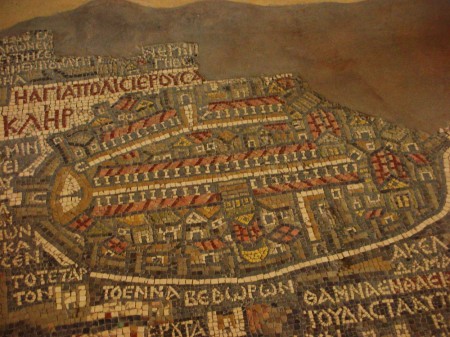
The ancient Madaba map shows the walled city of Jerusalem in the 3/4 view style, unique for this period of time. Millions of tiles went into creating the entire original map
Thursday was completely packed from morning until night. We left early in our rented car, a Chevy Epica (one of the non-American models that you only find while overseas) to go to Madaba, where my guide book said there was the oldest map of the Holy Land ever discovered, buried in the floor of an old church. After getting a little lost for half an hour and enjoying driving in circles through Madaba, I finally saw a glimpse of what could have been a church’s spire over the roofs of houses, and then it was only a few more minutes of trying to figure out what roads to take. The admission was inexpensive and we were there early enough in the morning that we avoided the packs of tour buses (which were starting to arrive as we left). Going to Arab Orthodox churches is always interesting because of their massive collections of statues and huge paintings all over the walls, almost as if they’re setting themselves in direct opposition to the iconoclast Muslim beliefs. One thing that we noticed were the numerous references to St. George (being born, preaching, slaying a dragon, etc) which made sense considering that the name of the building we were in was the “Church of St. George.”
After we left, Christine was getting hungry, and as we wandered the streets of Madaba looking for something to eat, we saw a guy in a little corner shop making, oddly enough, pancakes. Both of us stopped and stared at this novelty in the Arab world, and eventually bought a “sack o’ pancakes” for one whole dinar. After taking one bite, we quickly learned why pancakes are a novelty in Jordan; these were somehow a combination of dry and slimy, while otherwise being utterly without flavor. As Christine unwound a hair from her mouth and stared at it with a raised eyebrow, I ducked into a nearby teashop, explained to the two young guys working at it the situation with the pancakes, and that we needed some tea, ASAP. They laughed, sniffed the bag and withdrew quickly. As Christine and I recovered from the pancake problem with hot cups of minty red tea, I tried to explain who we were and where we were going that day. They asked a lot of questions, which I understood about 40% of, but apparently they were pleased enough with my grasp of Arabic that they refused to take any money for the tea. Christine was, of course, duly impressed (as for me, I was just surprised as I still think that Arabs are laughing at me most of the time when I try to speak their language).
Our next stop was Mount Nebo, just half an hour to the northwest of Madaba and the site where Moses looked down over what would eventually be Israel, and died soon afterward – people have been unable to determine whether he was actually buried somewhere on the mountain or somewhere else, as mentioned in Deuteronomy 32 and 34. As it was almost 11 in the morning now, the tourists had arrived in full force in their massive air conditioned buses and were wandering about, speaking multiple languages and staring suspiciously at the Jordanian guards that were around the famous holy site. We arrived at the same time as two buses of Italians, and since Christine is able to speak Spanish fluently, she was able to ask their guide questions about finding things on the mountain – what luck!
One thing that I had been looking forward to seeing was the beautiful cross sculpture on the pinnacle of the mountain with a serpent wrapped around it, which had been made back in 1996 by an Italian sculptor named Giovanni Fantoni (perhaps that’s one of the reasons why there were so many Italians present, too). As the two of us stood with the Italians on the terraced plateau looking out over the Holy Land, I suddenly heard a familiar twanging dialect behind us that certainly wasn’t European. I hazarded a glance behind me to see a group of elderly people listening attentively to a man who was standing on a chair, wearing a hat that said “Jesus Saves” and preaching loudly about Moses’ final tasks on Mount Nebo in a drawling monologue.
Christine wanted to look for the Temple of Moses, about which our guidebook was rather ambiguous about. We browsed a museum which had some notes about the shrines which had been present on the mountain in early centuries, but we found nothing conclusive to answer her question, and the Italians had vanished. Somewhat hesitantly, I approached the guide with the “Jesus Saves” hat and asked him our question. His eyes lit up and he pulled out his Bible, saying “That’s an excellent question and I’m happy to answer! If we look right here in the scripture, we can see that the Temple may or may not have been here before approximately…” and that was the last thing I can remember after about 10 minutes of him describing the Biblical significance of possible locations of Moses’ tomb. He introduced himself to us as Tim, and after he learned we were from Madison, he was like “oh really…?” and from that it didn’t take him long to question us eagerly, “Have you two been blessed with the holy word of the Lord?” Christine shot a glance over at me, and I cheerfully answered, “Sure have, Tim!” “Praise be to God!” he returned, pounding me on the back (actually looking slightly disappointed). “Let’s pray together here on the mountain; can I pray for you here now?” Why not, I agreed with a big smile on my face. Tim took our hands and prayed in that deeply passionate way that southerners are probably known for. Meanwhile, the rest of his congregation ambled out of the museum, smiling amicably and one guy who looked sunburned enough to be an Arab himself squinted an eye at us darkly and said something to us that was literally unrecognizable because his drawl was so thick. Christine and I smiled and got out of there as fast as we could. As we walked down the path back to our car, Christine frowned and pointed out that he never actually did answer the original question even though he preached to us for fifteen minutes.
From the top of the mountain range overlooking the Jordan Valley, I got the chance to test out the antilock brakes on the car as we zigzagged down the tiny twisting road, almost getting clipped by massive garbage trucks that came by way too frequently. Christine got to see some of the natural wildlife, camels and goats in their natural habitat; blocking the roads and staring blankly at us. After being here for seven months, I no longer view such things as adorably photogenic, but having Christine with me to take pictures made me recall nostalgically my early days in Jordan when I would have taken a picture (or a dozen) of a donkey or camel instead of cursing at it and punching the horn (neither of which do anything anyway, unfortunately). But after another half hour of driving along the now-familiar highway beside the Dead Sea (which we’d be seeing tomorrow for the bike ride) we had reached the entrance of the Baptismal Site, where a little less than 2000 years ago Jesus got himself publicly blessed by the Holy Spirit in the form of a dove and a lot of other great things happened.
We both paid our 8 dinars for tickets (no amount of Arabic smooth-talking could save me from that price since I don’t have a national ID card) and waited a little while for the tour bus to arrive with our guide, Hsam, who explained to our group that the actual Jordan River and site of the baptism was still another 20 minutes away by bus ride. I never ceased to be amazed by the difference in fertility of the land around the river compared with the rest of Jordan, and as the bus drew closer and closer, pine trees, palms and multitudes of flowers sprang up around us. More than that, for the first time since my arrival in the country I heard the sounds of birdsong such as I hadn’t experienced since living in the Lakeshore dorms back in Madison. If there hadn’t been Jordanian guards and Israeli spies all around us here at the border between countries, I would have called it a perfect place to live.
Our tour group dismounted and we wound our way along narrow, well-kept paths towards the river, which came up to us suddenly as a deep green chasm in the hill. Here at the edge of the water, the vegetation grew so tall and thick that it was difficult to see where the actual shores of the Jordan ended and the water began. Over the trees in front of us, we viewed a glint of gold, which Hsam told us was actually not in the West Bank but on the Jordanian side because of the extent of the river’s twists and turns. In only a few minutes more, we reached the actual site of the baptism, or as I suggested skeptically to Hsam, the closest possible estimate. I’ve never been convinced that any modern technology can find the exact location of an ancient occurrence because there’s usually no actual evidence left behind, and in this case, the natural fact that rivers will naturally change course. That thought seemed likely, as there was no connection between the river and the site, and it didn’t look like there had been for a long time. Hsam assured us that this was normal depending on the amount of rain Jordan was (or wasn’t) getting. The water looked more like a mosquito pool than the site of the Lord’s baptism, but I guess that’s bound to happen when the tourist bureau has to keep pumping it in from the river 20 meters away in order to provide us tourists with something Holy to look at. I know, I sound cynical, but I was really hoping for a little bit more inspirational to the site than a concrete well and a pit of stagnant water. Oh well. Look at the picture for yourself:
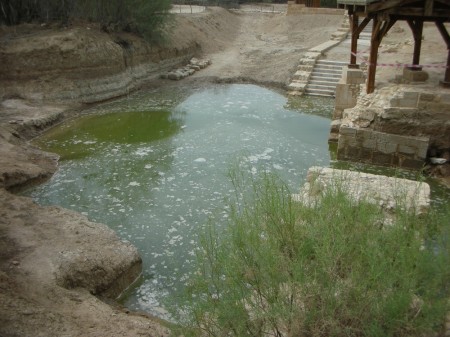
Sure it's a holy site, but I was really hoping for, you know, an actual river instead of a green pool
It was a short walk from there to the gold-steepled church, and also a place along the river where the path came close enough that people could go right up to it and dip our feet in, which of course Christine and I did. The bottom was quite muddy and felt wonderful on our tired feet, as I imagine Jesus’ feet must have been by the time he made it all the way down into the valley from Judea. We gave the church itself a quick look over, but unfortunately Hsan didn’t come in with us to explain its signifcance or history, and all I know of it even now is that there was a bored-looking monk inside selling vials of holy water next to a cash register. No further comment.
I still wanted to go up north to Jerash before going to Haitham’s house in Zarqa for dinner, but Christine and I hadn’t eaten all day except for horrific pancakes, so we stopped at the Baptismal Fish Fry on the highway near the visitor’s center and had some delicious Halloumi cheese with lemon and onion sauce (no fish, as I don’t like them and Christine’s a vegetarian). Haitham called around then and anxiously demanded that I give him some ideas on vegetarian food that his mother could make for Christine. “Shall I just have her make veggie pizza then?” he questioned me, and I told him that anyone can eat pizza anywhere, but she’d probably like to taste something more Arabic during her brief stay here.
Now, our tour book was telling us that Jerash’s Roman ruins were kept open until one hour before sunset, which the morning’s forecast had stated to be at 6 in the evening. So imagine my chagrin when we pulled into the parking lot, still filled with tourists, and learned that the park had closed 15 minutes earlier at four o’clock. “This book says that you are open until almost sunset!” I angrily told the plump little guard who was leaning lazily against the closed window. “This is the winter schedule,” he responded in a bored tone. “But you can go quite a ways into the ruins before they will ask you for a ticket.” I was determined that our trip up north would not end at a barred gate, so we took him up on his offer and headed in. We were able to see the ancient Roman hippodrome where every day they reenact chariot races (although of course we were too late for that) and the massive Hadrian’s Arch, which was built in 129 AD to celebrate Emperor Hadrian’s visit from the Rome. The arch must have been only modestly sized by ancient standards like the Pyramids and the Great Wall, but since it’s right next to the major highway in and out of the modern town of Jerash, it looks huge next to the tiny semis and trucks the roar past it.
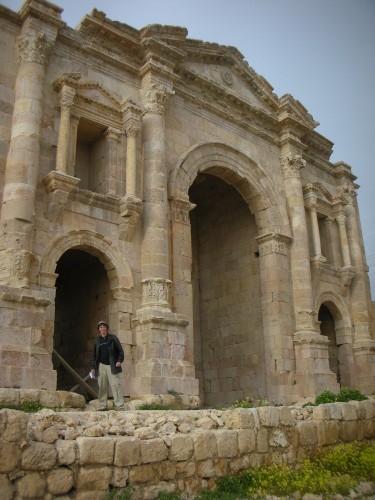
The arch and its ornamentation is remarkably well preserved considering it's had no protection from the elements
It didn’t take long before we were stopped at another smaller and newer-looking arch that blocked further passage into the ruins. Behind the guard I could see fields of golden flowers and cobbled paths leading up hills crowned with ancient columns. The first guard I spoke to was completely adamant – without a ticket, there was no getting in. “The man at the bottom wouldn’t give us tickets,” I told him in Arabic. He frowned thoughtfully at this, then brought over another man with slightly more doodads on his shirt, who had me explain to him my work in Jordan and how we’d traveled “all day” to reach Jerash. He frowned sympathetically and said, “All right, I can let you in for ten minutes for free, but come right out because I’m not supposed to do this.” So Christine and I got our 10 free minutes, and I have to say that those 10 free minutes were gorgeous enough to definitely make me want to come back there and pay full price.
Jerash’s Roman ruins are famous for being the best preserved in the world, although after a major earthquake in the mid 8th century destroyed much of the ancient city, the place lay silent and essentially forgotten by the west for a thousand years until Bedouin guides revealed it to European explorers. The beautiful hills and yellow fields of flowers that surround the ancient bleached stones are particularly lovely this time of year before the summer sun kills off the flowers. We only had a few minutes to take it all in, but seconds after thanking the guards and squeezing through the arch, we found ourselves in the immense Oval Plaza, mysteriously crowned by a single column standing in the center of the oval. What was its purpose? We didn’t have time to find out, unfortunately. As we left, the guard had brought a manager who apologized again for the inconvenience of the winter/summer schedules and thanked us for coming. Jordanians are notorious sticklers to doing things “by the book – unless you have wusta around it” but at least they’re apologetic for it.
The ride back south to Zarqa from Jerash looked like a different country to me. I do most of my traveling in the south of Amman when biking and I’ve only been up in the north a few times. This region between Jerash and Amman was filled with beautiful slopes, groves of olives trees, and looked like how imagine Italy or Greece would be like, or maybe my perceptions were a little colored because our most recent tourist stop. Jeff had worked there a couple years ago for a Habitat for Humanity build and told me before that although it’s a beautiful place, the people are some of the most conservative in all of Jordan, which can make it uncomfortable for Westerners there if you’re in the area for awhile. But as a visitor, I thought it was simply splendid compared with the bland gray wasteland of the south deserts. I got a little lost and a little late coming into Zarqa from a different road than I always had before, on the bus from Amman. Thankfully, Arabs are the the nicest people in the world when it comes to giving you directions, and after several stops, two of them just climbed in the car with us off the street and directed us, with Haitham’s help on the phone, directly to his front door. They then hopped out, hands were shaken all around, and they headed back in the direction that we had come. Arabs are a lost guy’s best friend.
At Haitham’s house, his mother quickly brought out steaming plates of a sweet green paste, rice, and a vegetable salad, and then watched proudly from the door as we dug in. Haitham’s sister Sousa, a year younger than he, came out and sat with us too, which she usually wouldn’t do if it had just been me (wouldn’t be proper) but since Christine was with me, she made an exception to the standard Islamic policies. Per Haitham’s request though, I agreed I wouldn’t put up any pictures of the female members of his family with us – policy can only be bent so far! After dinner, the entire family joined us and we talked about travel, Jordan, and America. Haitham’s mother was overjoyed that Christine came to visit, and promised her that she would bake her a cake to take back to America.
The following morning, we slept in a little later than I had planned, but I still had time to show Christine the famous Abdali market that I first saw all those months ago in early September. I hadn’t been there in quite awhile (although I should go back to pick up some dress pants for choir) but it was as busy and crowded as always, except this time I could understand a little more clearly what the vendors were shouting at everyone (this was not always a good thing). Coincidentally enough, I ran into one of the students from Ayn al Basha selling in a stall, who recognized “Mr. Zach” right away. He wasn’t in my class, so unfortunately I didn’t know his name, but he was overjoyed that I had stopped by and pressed my hand full of…free batteries? We had been looking for replacements for Christine’s camera, and the vendor/student wanted to help out however he could. Have I mentioned how generous Arabs are?
The main event for the day, though, was the weekly bike ride with Cycling Jordan. We were too late for the morning ride and so instead we went on the 11 o’clock desert ride, rather unexpectedly because I thought they’d be doing the Dead Sea route as usual. The weather was unfortunately far windier than what’s good for biking, and since we went out into the desert near the Palestinian border, we were constantly getting hit in the face with sand. We were out with a group of students from Jordan University who were curious as to what we were doing “visiting Jordan.” “I work here,” I responded with a smile, “and she’s visiting.” I enjoy people’s incredulous reactions when I say that, especially young people, who get this look of “What kind of American would want to leave America and come to Jordan?” I often like to reply with a cryptic response, like “Helpful Americans,” except I stopped doing that lest they think I’m some kind of CIA mole or something. This is a generation of Jordanians that have been raised on Prison Break, 24, and Lost – I don’t want to stimulate their imaginations any more than that junk already has.
After arriving back in Amman at the conclusion of our windy ride, we threw some stuff into backpacks and hit the highway. I had hoped that we could make it from Amman down to Wadi Musa and Petra before sunset, but it took me awhile to get the hang of how Jordanian “unwritten rules of the road” work so I took it slower than I would have liked. I’ve commented on this before, as when I watched Khalil or Wajih drive, but there’s an entire code of honks, flashing of lights, and swerving that takes place in order to communicate whether you’re planning on passing, following, or whether there’s a cop over the next hill (I really like that last one). However, it’s not like Jordanian cops try to be stealthy – unlike in the states where their squad cars seem like they’re hidden in duck blinds around the blindest corner in the county, here they’ll just park on an entirely flat stretch of highway, lights on full blast, only blaring their sirens whenever someone goes by too fast. They just don’t give a dang. And unfortunately, this probably plays a part in why Jordan has an extremely high per capita death rate in car accidents. We were both pretty tired from our biking-into-the-wind that morning, so we kept ourselves awake with a combination of Red Bull and Weird Al singing. Good times; I don’t think anyone else in Jordan has even heard of Weird Al!
It took almost exactly three hours to reach the village of Wadi Musa, arriving at about 9 at night. The friendly owner of the Petra Gate Hotel, Nasser, welcomed me as “Mr Zah-ch” – a non-uncommon greeting for people who have only communicated with me via email before; it’s tough to explain that it’s just another English grammar rule which gets broken and that my name is actually “Zak” – like the Arabic spelling is three letters as well, زاك, from right to left, zay alif kaff. Nasser asked us if we were married, and when we said we weren’t, he asked to see our passports to make sure that neither of us were somehow Jordanians trying to sneak off to a hotel. All problems averted, he personally escorted us up to our room, which was small, and old, but very neat and clean. There was an ancient washed-out photo on the wall of a baby staring at us, which we stared back at for a moment. “Interesting baby,” I commented to Nasser, who leaped over and said, “If you don’t like it, I will take it down right now!” We chuckled, and then started to unpack until he actually came back into the room with a chair and started climbing up onto it to take down the photo. “Nasser! It’s no big deal!” I called to him, and it took 2-3 more times of convincing before Nasser understood that we weren’t going to hurl ourselves from the window if the baby stared at us all night.
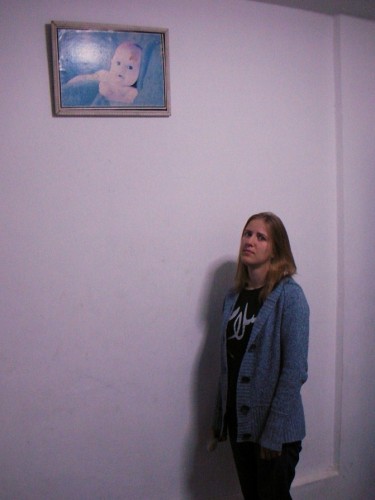
It was like we had our own personal creepy guardian angel, with weird brown blotches on his forehead. Yay.
The next morning, we enjoyed the continental breakfast of eggs, fruit, and bread the Nasser had prepared for us at 6:30, in order to leave early for Petra on the other side of town. This time I really wanted to see the sunlight hitting the Treasury building full on as in all of its most famous pictures; when I went with Haitham and the guys last time, it was already early afternoon and there was nothing but the drab muted shadows hitting the ancient rock face. I was prepared to make sure that mistake didn’t happen again by avoiding the Arab world delays to which I’ve become accustomed.
Christine and I had to place almost to ourselves in the morning, with nothing but the soft muted echo of donkey hooves in the Siq and the muttering of a few Korean tourists. It seemed like guides and vendors were even more persistent than last time, and they probably wasn’t my imagination because I wasn’t lucky enough to have Arabs with me to shoo them away this time. No, we two foreigners made an appealing target and I did end up buying several things from them at various points through the day, if for no other reason to then show the other ones, “Look, I bought one here already.” I have a piece of carved jewelry sitting in my room right now, just waiting for the next trip to Petra so that I can use that excuse. Because we had plenty of time, I had no qualms about taking Christine all the way to the farthest point in the entire park, the massive Monastery Ad-Deir, which is not actually a monastery but probably was used by the Nabateans for religious ceremonies or for public announcements.
This place is HUGE. Photos you see of it in travel magazines just can’t do it justice, because they’re usually left empty without any people in them for size comparison. And it’s deceptively small-looking from a distance, as well, because it looks like a larger, less ornamented version of the more-famous Treasury building. It’s not until you almost reach the doorway and you realize that it alone is the size of a two-story house. When Christine took the picture above, we learned how perfect this massive acoustic sounding board was for public announcements; even when I was talking in my normal voice, the large hollowed out chamber behind me amplified my voice resonantly and Christine could hear me like I was right in front of her.
Nearby to the monastery, there were a few crude hand-lettered signs loudly proclaiming, ‘This way to the end of the world!” which sounded too amazing to pass up. Although it may not have been the end of the world, it was a fairly dramatic drop-off separating the Petra mountains from the next range over. I was once again reminded how easily the Nabateans defended their land for centuries; with mountains like this there was no way that an invading army could conquer them until one such army got the idea to poison their water supplies instead. The black mountains surrounding us stood in stark contrast to the rosy red and yellow stone for which Petra is famous for.
The trips by foot up and down to the monastery take about half an hour each way. The little Bedouin children swarm about you with their pack animals when you’re at the bottom, smiling hopefully at you and offering “air conditioned taxi” to the top of the peak. I thought that we must have misheard them at first when they offered that, but then checked the trusty guidebook and learned, sure enough, that this was a common advertising tactic for the donkey rides. Unfortunately, as tempting as it might be – do not ride the donkey up the stairway! Not only do I hear it’s an uncomfortable, nerve-shattering ride to feel them leap almost straight up along the stairs, but even worse, the little donkey hooves are destroying the stairs themselves in only a few short decades. All the guidebooks agree that the donkeys, with their narrow sharp feet, are responsible for the “chiseling” away at the stairs which is very prevalent, and approaching dangerous in some places. So, if you want the stairs and the monastery to remain accessible for generations to come, use the legs that God gave you and do a little extra hiking. Okay, I’m off the soapbox now.
The other highlight of our trip was attempting to find our way to the High Place of Sacrifice, another point I wanted to make it to on my previous visit to Petra, but as the round trip takes an hour and a half, there’s no way I would have had time then. By this point, Christine and I had been hiking for about 7 hours, and probably made a slight mistake by not bringing up more water with us. Between slinging the guidebook between us, and the 2 liter bottle of water and getting lost in some side path in the wilderness for 15 minutes, we practically dragged ourselves onto the summit. Thankfully, the resourceful Bedouins have put “coffeeshops” at every possible flat spot larger than a wheelbarrow so you can always count on being able to find a drink somewhere. I put “coffeeshops” in quotes because we’re literally talking some boards nailed together with some cloth over the roof. But they do sell water, coffee, and soft drinks at outlandish prices for your convenience. Panting heavily, I collapsed against a rock near a Bedouin woman and scanned my guidebook looking for something to take pictures of, then frowned at a few lines. “Shu ismu hadek?” I questioned her, asking for the name of a rock column a few dozen meters. She said some name in English, but I pointed to the page and said, “Zib al Attuf?” – she turned a little more red and shook her head quickly, “No no no!” Zib, in Arabic, means phallus or other slang words for the male anatomy. The book tried to be accurate but apparently the Bedouins are a little embarrassed about that name.
We relaxed at the top of the High Place for a few minutes, sitting on the stone alter where, centuries ago, the Nabatean priests performed blood rituals under the setting sun. Because Nabatean religion was a combination of all kinds of European and Asian culture, it’s unknown where they only did animal sacrifices or whether they sacrificed a young boy each year like my guidebook suggests. However, because they also had some background with the Zoroastrians of Persia, they also definitely practiced posthumous exposure to the elements, and the wide flat tableau of the High Place would have been the perfect place to do it.
By the time we made it down from that relaxing spot on the mountain, the sun was close to setting and the Bedouins were shooing people back up towards the Siq. The stones are naturally very slippery all by themselves, since they’re crumbling sand, and so everyone needs to be out of the park before dark for liability reasons. Christine and I stopped for pizza at the same place Pat and his friends took me to last time when climbed Jebel Haroun, and the waiter gave us a discount because “you work here; you’re not one of these tourists.” I never would have guessed that speaking Arabic could be so profitable! A few more hours later and we were back in Amman, this time picking up Haitham from the bus station so that he could proudly present cakes to Christine and me, made by his mother just like she said. We had to get up early the next morning, about 5 AM, so that I could return Christine to the airport; too soon an end to a trip that I wish I could have lasted a lot longer than four days!
Already I’m planning for the next trip to Petra with my parents whenever they come to the country, and I think I’ve gotten the hang of driving here without any problems. There’s a lot more that’s been happening for the past few weeks, like a new job offer, the unceremonious “washing of the passport” (= not a good thing), and of course, the upcoming choir concerts for Easter – for the past two weeks in particular, practices have been almost every night. Those are my excuses; but from now on I plan on trying to make more frequent, smaller blog posts that don’t end up taking me three weeks to finish!
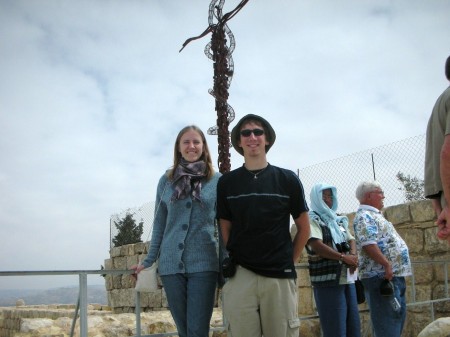
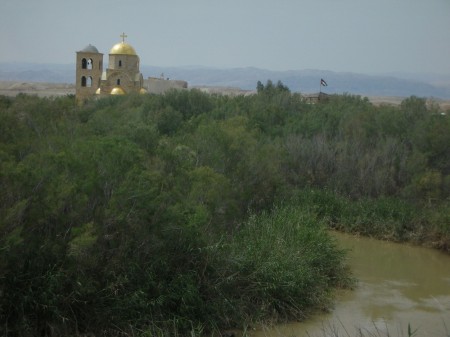
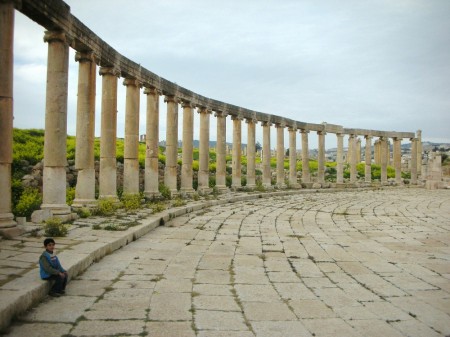
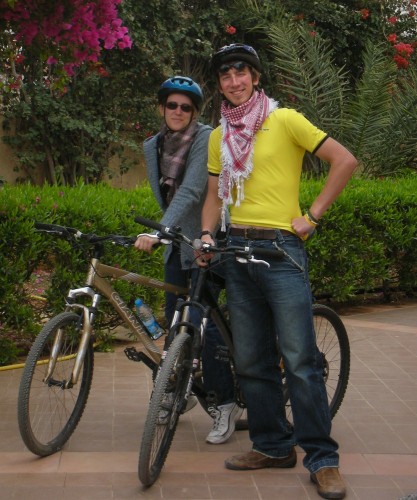
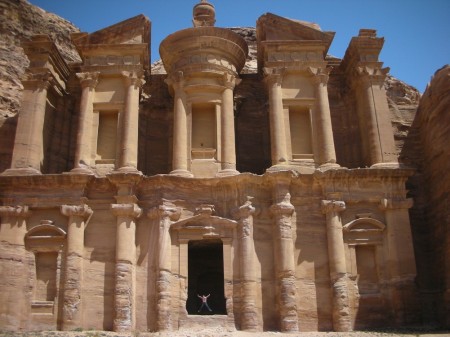
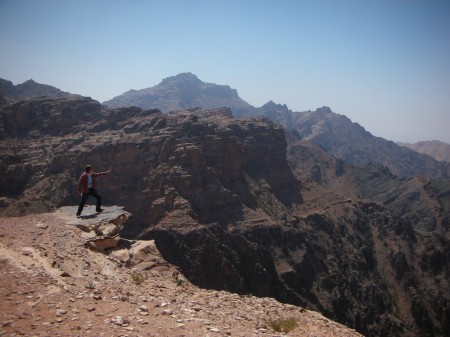


The free red bull must have been effective. I was ready to collapse after the concert but then my little one decided to throw a fit. Glad you stayed up and gave me something interesting to read. Your excursion to Madaba was fascinating on several levels. I recommend eating at Haret Judoudna next time you’re there. Amazing food and reasonable prices. See you at rehearsal! ~ Um Tulip
Zach, you should know better than to let strangers into your car to guide you! If I hear about you being beheaded, I’ll be most displeased with you.
I tell all of my friends and family this when they worry about me: Jordan is one of the safest countries to live in. For a city of its size (about 2.5 million) it has a very low crime rate because people are so ridiculously polite. Also, there’s the whole fear of God striking them down, as Haitham once told me.